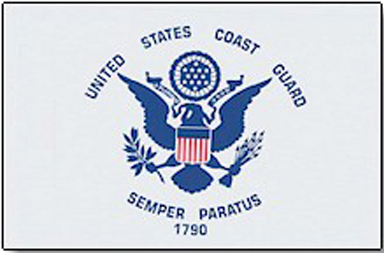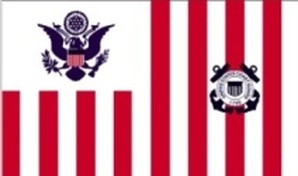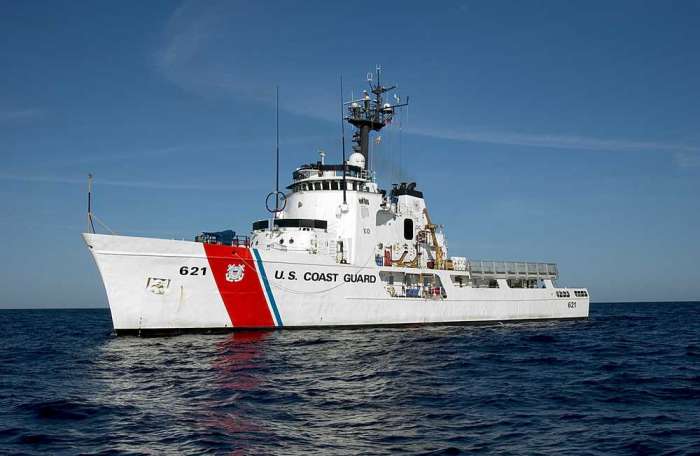The United States Coast Guard is one of five Armed Forces of the United States. It is this nation's oldest continuous seagoing service. The history of the Service is complicated because it is the amalgamation of five
Federal agencies: the Revenue Cutter Service, the Lighthouse Service, the Steamboat Inspection Service, the Bureau of Navigation, and the Lifesaving Service.
The history of the USCG can be traced to August 7, 1789 when one of its predecessors, the US Lighthouse Service, was established under the control of the Treasury Department.
On August 4, 1790, Congress authorized a maritime service to enforce customs laws. Alternately known as the System of Cutters, Revenue Service, and Revenue-Marine this service was placed under the control of the Treasury Department. (This is considered the official “birthday” of the U.S. Coast
Guard.)
On August 30, 1852, the Steamboat Inspection Service was formally established in the Department of the
Treasury.
In 1870, the Navigation Division was established in the Treasury Department to administer the fines
and penalties function under the navigation laws.
In June 18, 1878, the U.S. Life-Saving Service established as a separate agency under the control of the Treasury Department.
On January 28, 1915, President Woodrow Wilson signed into law the "Act to Create the Coast Guard."
That law combined the Life-Saving Service and Revenue Cutter Service to form the Coast Guard. (This
is the date that the Coast Guard was given its current name.)
On March 1, 2003, the Coast Guard formally transferred from the Department of Transportation to the newly-created Department of Homeland Security.
The multiple missions and responsibilities of the modern Coast Guard are directly tied to this diverse heritage. The Coast Guard is a service unique among the U.S. military branches for having a maritime law enforcement mission (with jurisdiction in both domestic and international waters) and a federal regulatory mission.
It now operates under the Department of Homeland Security during peacetime, and can be transferred to the Department of the Navy by the President at any time or by Congress during time of war.
The Coast Guard (or its predecessors) has been involved in every war since 1790. As of August 2009[update] the Coast Guard had approximately 42,000 men and women on active duty, 7,500 reservists, 30,000 auxiliarists, and 7,700 full-time civilian employees.
The Coast Guard motto is Semper Paratus ("Always Ready"). Official recognition was given to the Coast Guard motto in 1910. No one knows how this motto was chosen. But there is no doubt as to who put the famous motto to words and music. Captain Francis Saltus Van Boskerck wrote the words in 1922. He wrote the music five years later.
Federal agencies: the Revenue Cutter Service, the Lighthouse Service, the Steamboat Inspection Service, the Bureau of Navigation, and the Lifesaving Service.
The history of the USCG can be traced to August 7, 1789 when one of its predecessors, the US Lighthouse Service, was established under the control of the Treasury Department.
On August 4, 1790, Congress authorized a maritime service to enforce customs laws. Alternately known as the System of Cutters, Revenue Service, and Revenue-Marine this service was placed under the control of the Treasury Department. (This is considered the official “birthday” of the U.S. Coast
Guard.)
On August 30, 1852, the Steamboat Inspection Service was formally established in the Department of the
Treasury.
In 1870, the Navigation Division was established in the Treasury Department to administer the fines
and penalties function under the navigation laws.
In June 18, 1878, the U.S. Life-Saving Service established as a separate agency under the control of the Treasury Department.
On January 28, 1915, President Woodrow Wilson signed into law the "Act to Create the Coast Guard."
That law combined the Life-Saving Service and Revenue Cutter Service to form the Coast Guard. (This
is the date that the Coast Guard was given its current name.)
On March 1, 2003, the Coast Guard formally transferred from the Department of Transportation to the newly-created Department of Homeland Security.
The multiple missions and responsibilities of the modern Coast Guard are directly tied to this diverse heritage. The Coast Guard is a service unique among the U.S. military branches for having a maritime law enforcement mission (with jurisdiction in both domestic and international waters) and a federal regulatory mission.
It now operates under the Department of Homeland Security during peacetime, and can be transferred to the Department of the Navy by the President at any time or by Congress during time of war.
The Coast Guard (or its predecessors) has been involved in every war since 1790. As of August 2009[update] the Coast Guard had approximately 42,000 men and women on active duty, 7,500 reservists, 30,000 auxiliarists, and 7,700 full-time civilian employees.
The Coast Guard motto is Semper Paratus ("Always Ready"). Official recognition was given to the Coast Guard motto in 1910. No one knows how this motto was chosen. But there is no doubt as to who put the famous motto to words and music. Captain Francis Saltus Van Boskerck wrote the words in 1922. He wrote the music five years later.
The U.S. Coast Guard ensign is shown below. The design of the Coast Guard Ensign was established in 1799. The design represents the original 13 states. The only change since then has been the addition of the
Coast Guard anchors. As it was intended in 1799, the ensign is displayed as a mark of authority for boarding's, examinations and seizures of vessels for the purpose of enforcing the laws of the United States. The ensign is never carried as a parade or ceremony standard.
Coast Guard anchors. As it was intended in 1799, the ensign is displayed as a mark of authority for boarding's, examinations and seizures of vessels for the purpose of enforcing the laws of the United States. The ensign is never carried as a parade or ceremony standard.
The “Slash” or “Racing Stripe” of the US Coast Guard is shown below. In the early 1960s, President Kennedy wanted to improve "the visual identification" of the United States, both domestically and internationally. The red “slash” was recommended as a symbol that would easily distinguish the Coast Guard from other government agencies. It could also be easily applied to ships, boats, aircraft, and vehicles and used in other printed forms. The “slash” is a wide red bar to the right of a narrow blue bar, both canted at 64°. Centered on the red bar is the traditional Coast Guard emblem. This “racing stripe" was adopted on April 6, 1967.
Sources: www.uscg.mil/history
Traditions, 200 years of history, the Coast Guard Historian's office, July 1990.
Wikipedia
Traditions, 200 years of history, the Coast Guard Historian's office, July 1990.
Wikipedia




 RSS Feed
RSS Feed